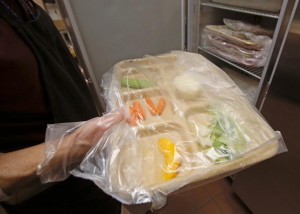Among consumer food handling practices, time-temperature abuse has been reported as one of the most common contributory factors in salmonellosis outbreaks where the evidence is strong.
 The present study performed storage tests of burgers, sausages, and kebabs and investigated (i) the effect of refrigerator temperatures (4°C versus 8 or 12°C, which were the temperatures recorded in 33 and 3%, respectively, of domestic refrigerators in Italy), with or without prior temperature abuse (25°C for 2 h, simulating transport of meats from shop to home), and (ii) the impact of the thawing method (overnight in the refrigerator at 8°C versus on the kitchen countertop at 23°C) on the presence and numbers of Salmonella bacteria.
The present study performed storage tests of burgers, sausages, and kebabs and investigated (i) the effect of refrigerator temperatures (4°C versus 8 or 12°C, which were the temperatures recorded in 33 and 3%, respectively, of domestic refrigerators in Italy), with or without prior temperature abuse (25°C for 2 h, simulating transport of meats from shop to home), and (ii) the impact of the thawing method (overnight in the refrigerator at 8°C versus on the kitchen countertop at 23°C) on the presence and numbers of Salmonella bacteria.
Storage tests were carried out on naturally or artificially (Salmonella enterica serovar Typhimurium at ca. 10 CFU/g) contaminated products, while freezing-thawing tests were conducted only on artificially contaminated products (Salmonella Typhimurium at ca. 10, 100, and 1,000 CFU/g).
The results from the artificially contaminated products showed significant (P < 0.05) growth of Salmonella Typhimurium at 12°C (i.e., from ca. 8 most probable number [MPN]/g to . 710 MPN/g) in kebabs after 7 and 10 days but more moderate growth in sausages (i.e., from ca. 14 MPN/g to a maximum of 96 MPN/g after 9 days of storage).
Storage of naturally contaminated burgers or sausages (contamination at or below 1 MPN/g) at 4, 8, or 12°C and a short time of temperature abuse (2 h at 25°C) did not facilitate an increase in the presence and numbers of Salmonella bacteria. Thawing overnight in the refrigerator led to either a moderate reduction or no change of SalmonellaTyphimurium numbers in burgers, sausages, and kebabs.
Overall, this study showed that domestic storage and thawing practices can affect food safety and that time-temperature abuse can cause a substantial increase of Salmonella numbers in some types of poultry-based meat preparations, highlighting that efforts for the dissemination of consumer guidelines on the correct storage and handling of meats need to be continued.
Effects of domestic storage and thawing practices on Salmonella in poultry-based meat preparations
Journal of Food Protection, Number 12, December 2015
Anna Roccato, Mieke Uyttendaele, Veronica Cibin, Federica Barrucci, Veronica Cappa, Paola Zavagnin, Alessandra Longo, Paolo Catellani, and Andantonia Ricci
http://www.ingentaconnect.com/content/iafp/jfp/2015/00000078/00000012/art00002










